Definition, Formula, Equation, Comparision, Solved Example Problems - Torque and Angular Momentum | 11th Physics : UNIT 5 : Motion of System of Particles and Rigid Bodies
Chapter: 11th Physics : UNIT 5 : Motion of System of Particles and Rigid Bodies
Torque and Angular Momentum
TORQUE AND ANGULAR MOMENTUM
When
a net force acts on a body, it produces linear motion in the direction of the
applied force. If the body is fixed to a point or an axis, such a force rotates
the body depending on the point of application of the force on the body. This
ability of the force to produce rotational motion in a body is called torque or
moment of force. Examples for such motion are plenty in day to day life. To
mention a few; the opening and closing of a door about the hinges and turning
of a nut using a wrench.
The
extent of the rotation depends on the magnitude of the force, its direction and
the distance between the fixed point and the point of application. When torque
produces rotational motion in a body, its angular momentum changes with respect
to time. In this Section we will learn about the torque and its effect on rigid
bodies.
Definition of Torque
Torque
is defined as the moment of the external applied force about a point or axis of
rotation. The expression for torque is,

where, ![]() is the position vector of the point where the force
is the position vector of the point where the force ![]() is
acting on the body as shown in Figure 5.4.
is
acting on the body as shown in Figure 5.4.

Here,
the product of ![]() and
and ![]() is called the vector product or cross product. The
vector product of two vectors results
in another vector that is perpendicular to both the vectors (refer Section
2.5.2). Hence, torque
is called the vector product or cross product. The
vector product of two vectors results
in another vector that is perpendicular to both the vectors (refer Section
2.5.2). Hence, torque ![]() ) is a vector quantity.
) is a vector quantity.
Torque has a magnitude ( rFsinθ ) and direction perpendicular to ![]() and
and ![]() . Its unit is N m.
. Its unit is N m.

Here,
θ is the angle between ![]() and
and ![]() , and nˆ is
the unit vector in the direction of
, and nˆ is
the unit vector in the direction of ![]() . Torque (
. Torque (![]() ) is sometimes called as a pseudo vector as it needs the other two vectors
) is sometimes called as a pseudo vector as it needs the other two vectors ![]() and
and ![]() for its existence.
for its existence.
The
direction of torque is found using right hand rule. This rule says that if
fingers of right hand are kept along the position vector with palm facing the
direction of the force and when the fingers are curled the thumb points to the
direction of the torque. This is shown in Figure 5.5.
The
direction of torque helps us to find the type of rotation caused by the torque.
For example, if the direction of torque is out

of
the paper, then the rotation produced by the torque is anticlockwise. On the
other hand, if the direction of the torque is into the paper, then the rotation
is clockwise as shown in Figure 5.6.

In many cases, the direction and magnitude of the torque are found separately.
For direction, we use the vector rule or right hand rule. For magnitude, we use
scalar form as,

The
expression for the magnitude of torque can be written in two different ways by
associating sin θ either with r or F in the following
manner.

Here,
(F sinθ) is the component of ![]() perpendicular to
perpendicular to ![]() . Similarly, ( r sinθ) is the component of
. Similarly, ( r sinθ) is the component of ![]() perpendicular to
perpendicular to ![]() . The two cases are shown in Figure 5.7.
. The two cases are shown in Figure 5.7.


Torque about an Axis
In
the earlier sections, we have dealt with the torque about a point. In this
section we will deal with the torque about an axis. Let us consider a rigid
body capable of rotating about an axis AB as shown in Figure 5.8. Let the force
F act at a point P on the rigid body. The
force F may not be on the plane ABP. We
can take the origin O at any random point on the axis AB.

Th e torque of the force ![]() about O is,
about O is, ![]() =
= ![]() x
x![]() . Th e component of the torque along the axis is the torque of
. Th e component of the torque along the axis is the torque of ![]() about the axis. To find it, we should first find the vector
about the axis. To find it, we should first find the vector ![]() = |
= |![]() x
x![]() | and then find the angle φ between
| and then find the angle φ between ![]() and AB. (Remember here,
and AB. (Remember here, ![]() is not on the plane ABP). Th e torque about AB is the parallel component of the torque along AB, which is |
is not on the plane ABP). Th e torque about AB is the parallel component of the torque along AB, which is | ![]() x
x![]() | cos φ. And the torque perpendicular to the axis AB is |
| cos φ. And the torque perpendicular to the axis AB is | ![]() x
x![]() | sin φ|.
| sin φ|.
The
torque about the axis will rotate the object about it and the torque
perpendicular to the axis will turn the axis of rotation. When both exist
simultaneously on a rigid body, the body will have a precession. One can witness the precessional motion in a spinning
top when it is about to come to rest as shown in Figure 5.9.
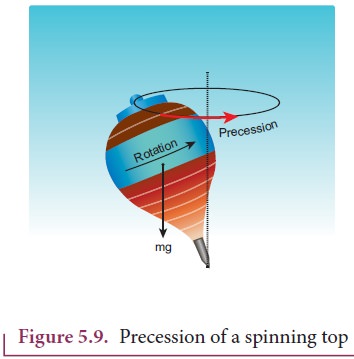
Study
of precession is beyond the scope of the higher secondary physics course.
Hence, it is assumed that there are constraints to cancel the effect of the
perpendicular components of the torques, so that the fixed position of the axis
is maintained. Therefore, perpendicular components of the torque need not be taken
into account.
Hereafter,
for the calculation of torques on rigid bodies we will:
a.
Consider only those forces that lie
on planes perpendicular to the axis (and do not intersect the axis).
b. Consider position vectors which are perpendicular to the axis.
The
torque of a force about an axis is independent of the choice of the origin as
long as it is chosen on that axis itself. This can be shown as below.
Let
O be the origin on the axis AB, which is the rotational axis of a rigid body. F
is the force acting at the point P. Now, choose another point O’ anywhere on
the axis as shown in Figure 5.10.

The
torque of F about O’ is,
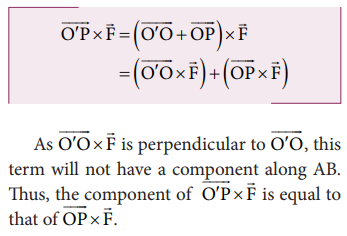
Torque
and Angular Acceleration
Let
us consider a rigid body rotating about a fixed axis. A point mass m in the
body will execute a circular motion about a fixed axis as shown in Figure 5.11.
A tangential force ![]() acting on the point mass produces the
necessary torque for this rotation. This force
acting on the point mass produces the
necessary torque for this rotation. This force ![]() is perpendicular
to the position vector
is perpendicular
to the position vector ![]() of the point mass.
of the point mass.

The
torque produced by the force on the point mass m about the axis can be written
as,

Hence,
the torque of the force acting on the point mass produces an angular
acceleration ( α) in the
point mass about the axis of rotation.
In
vector notation,

The
directions of τ and α are along the axis of rotation. If
the direction of τ is in the direction of α, it produces angular acceleration. On the other hand if, τ is opposite to α, angular deceleration or
retardation is produced on the point mass.
The
term mr2 in equations 5.14 and 5.15 is called moment of inertia (I)
of the point mass. A rigid body is made up of many such point masses. Hence,
the moment of inertia of a rigid body is the sum of moments of inertia of all
such individual point masses that constitute the body ( I = ∑mi ri2
). Hence, torque for the rigid body can be written as,

We
will learn more about the moment of inertia and its significance for bodies
with different shapes in section 5.4.
Angular Momentum
The angular
momentum in rotational motion is equivalent to linear
momentum in translational motion.
The angular momentum of a point
mass is defined as the moment of its linear momentum. In other words, the
angular momentum L of a point mass having a linear momentum p at a position r
with respect to a point or axis is mathematically written as,

The
magnitude of angular momentum could be written as,

where,
θ is the angle between ![]() and
and ![]() .
. ![]() is
perpendicular to the plane containing
is
perpendicular to the plane containing ![]() and
and ![]() . As we have written
in the case of torque, here also we can associate sin θ with either
. As we have written
in the case of torque, here also we can associate sin θ with either ![]() or
or ![]() .
.

where,
p⊥ is the component of linear momentum
p perpendicular to r, and r⊥ is the component of position r perpendicular to p.
The
angular momentum is zero ( L = 0 ), if the linear momentum is zero (p = 0) or if the particle is at the origin (![]() = 0) or if
= 0) or if ![]() and
and ![]() are parallel or antiparallel to each other (0 0 or 1800).
are parallel or antiparallel to each other (0 0 or 1800).
There is a misconception that the angular momentum is a quantity that is associated only with rotational motion. It is not true. The angular momentum is also associated with bodies in the linear motion. Let us understand the same with the following example.
Angular Momentum and Angular Velocity
Let
us consider a rigid body rotating about a fixed axis. A point mass m in the
body will execute a circular motion about the fixed axis as shown in Figure
5.12.

The
point mass m is at a distance r from the axis of rotation. Its linear momentum
at any instant is tangential to the circular path. Then the angular momentum ![]() is perpendicular to
is perpendicular to ![]() and
and ![]() . Hence, it is directed along the axis
of rotation. The angle θ between
. Hence, it is directed along the axis
of rotation. The angle θ between ![]() and
and ![]() in this case is 90o.
The magnitude of the angular momentum L could be written as,
in this case is 90o.
The magnitude of the angular momentum L could be written as,
L
= rmv sin90o = rmv

where,
v is the linear velocity. The relation between linear velocity v and angular
velocity ω in a circular motion is, v = r ω. Hence,

The
directions of L and ω are along the axis of rotation. The
above expression can be written in the vector notation as,

As
discussed earlier, the term mr2 in equations 5.22 and 5.23 is called
moment of inertia (I) of the point mass. A rigid body is made up of many such
point masses. Hence, the moment of inertia of a rigid body is the sum of
moments of inertia of all such individual point masses that constitute the body
( I = ∑mi ri 2
). Hence, the angular momentum of the rigid body can be
written as,

The
study about moment of inertia (I) is reserved for Section 5.4.
Torque
and Angular Momentum
We
have the expression for magnitude of angular momentum of a rigid body as, L = I ω . The expression for magnitude of
torque on a rigid body is, τ = I α
We
can further write the expression for torque as,

Where,
ω is angular velocity and a is angular acceleration. We can
also write equation 5.26 as,
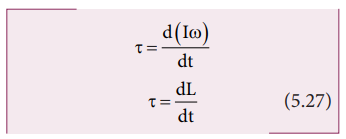
The
above expression says that an external torque on a rigid body fixed to an axis
produces rate of change of angular momentum in the body about that axis.
This
is the Newton’s second law in rotational motion as it is in the form of F = dp/dt which holds good for translational motion.
Conservation of angular momentum:
From
the above expression we could conclude that in the absence of external torque,
the angular momentum of the rigid body or system of particles is conserved.

The
above expression is known as law of conservation of angular momentum. We will
learn about this law further in section 5.5.
Solved
Example Problems for Torque
Example 5.7
If the force applied is perpendicular to the handle of the spanner as shown in the diagram, find the (i) torque exerted by the force about the center of the nut, (ii) direction of torque and (iii) type of rotation caused by the torque about the nut.

Solution
Arm length of the spanner, r = 15 cm = = 15×10−2m
Force, F = 2.5 N
Angle between r and F, θ = 90o

(i) Torque, τ θ = rF sin
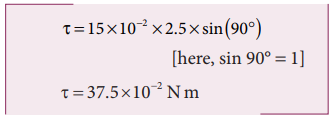
(ii) As per the right hand rule, the direction of torque is out of the page.
(iii) The type of rotation caused by the torque is anticlockwise.
Example 5.8
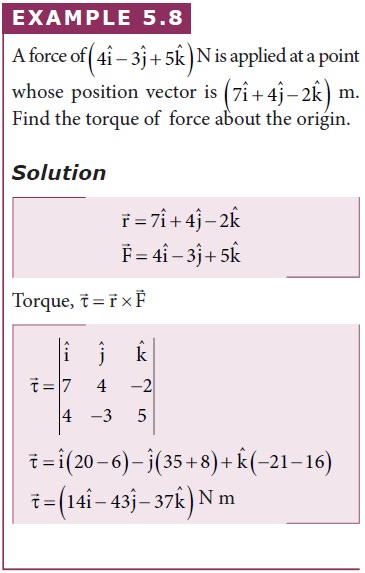
Example 5.9
A crane has an arm length of 20 m inclined at 30o with the vertical. It carries a container of mass of 2 ton suspended from the top end of the arm. Find the torque produced by the gravitational force on the container about the point where the arm is fixed to the crane. [Given: 1 ton = 1000 kg; neglect the weight of the arm. g = 10 ms-2]

Solution
The force F at the point of suspension is due to the weight of the hanging mass.

We can solve this problem by three different methods.
Method – I
The angle (θ) between the arm length (r) and the force (F) is, θ = 150o
The torque (τ) about the fixed point of the arm is,

Method – II
Let us take the force and perpendicular distance from the point where the arm is fixed to the crane.

Method – III
Let us take the distance from the fixed point and perpendicular force.

All the three methods, give the same answer
Solved
Example Problems for Torque about an Axis
Example 5.10
Three mutually perpendicular beams AB, OC, GH are fixed to form a structure which is fixed to the ground firmly as shown in the Figure. One string is tied to the point C and its free end D is pulled with a force F. Find the magnitude and direction of the torque produced by the force,
i. about the points D, C, O and B
ii. about the axes CD, OC, AB and GH.

Solution

The torque of a force about an axis is independent of the choice of the origin as long as it is chosen on that axis itself. Th is can be shown as below.
Let O be the origin on the axis AB, which is the rotational axis of a rigid body. F is the force acting at the point P. Now, choose another point O’ anywhere on the axis as shown in Figure 5.10.

Solved
Example Problems for Angular Momentum
Example 5.11
A particle of mass (m) is moving with constant velocity (v). Show that its angular momentum about any point remains constant throughout the motion.
Solution

The term ( OQsinθ ) is the perpendicular distance (d) between the origin and line along which the mass is moving. Hence, the angular momentum of the particle about the origin is,

The above expression for angular momentum L, does not have the angle θ. As the momentum (p = mv) and the perpendicular distance (d) are constants, the angular momentum of the particle is also constant. Hence, the angular momentum is associated with bodies with linear motion also. If the straight path of the particle passes through the origin, then the angular momentum is zero, which is also a constant.
Related Topics